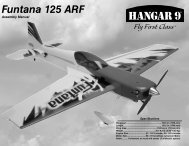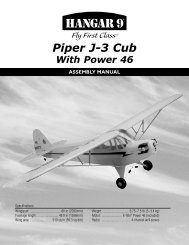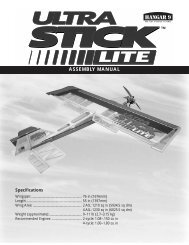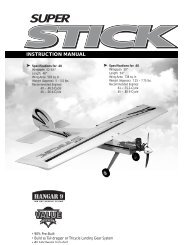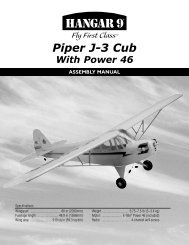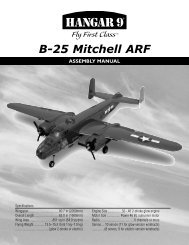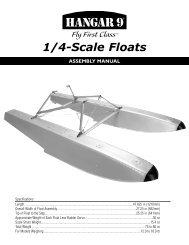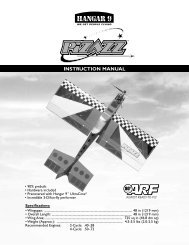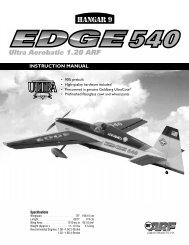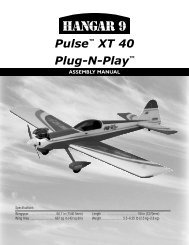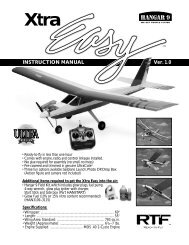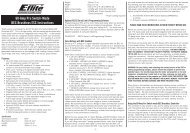Instruction Manual - Horizon Hobby
Instruction Manual - Horizon Hobby
Instruction Manual - Horizon Hobby
Create successful ePaper yourself
Turn your PDF publications into a flip-book with our unique Google optimized e-Paper software.
Tape StripSection 1. Assemble WingSection 2. Mount Main Landing GearWood Screws2
Section 3. Bolt on TailLarge WashersSmall WashersLong ScrewsRubber Bands (4 per side to hold wing)Assembly DiagramPlease carefully read through the entireinstruction manual before beginning assemblyof the Arrow Semi-Symmetrical Trainer Ready-To-Fly (RTF) kit.3
Table of ContentsAssembly Diagram . . . . . . . . . . . . . . . . . . . . . . . . . . . . . . . . . . . . . . . . . . . . . . . . . . . . . . . . . . . . . . . . . . . . . . . . . . . . . . . . . . . . . . . 2Large Parts Layout . . . . . . . . . . . . . . . . . . . . . . . . . . . . . . . . . . . . . . . . . . . . . . . . . . . . . . . . . . . . . . . . . . . . . . . . . . . . . . . . . . . . . . . 4Small Parts Layout . . . . . . . . . . . . . . . . . . . . . . . . . . . . . . . . . . . . . . . . . . . . . . . . . . . . . . . . . . . . . . . . . . . . . . . . . . . . . . . . . . . . . . . 4Section 1: Assembly of the Wing . . . . . . . . . . . . . . . . . . . . . . . . . . . . . . . . . . . . . . . . . . . . . . . . . . . . . . . . . . . . . . . . . . . . . . . . . . . . 5Section 2: Installing the Main Landing Gear/Wing Hold-Down Dowels . . . . . . . . . . . . . . . . . . . . . . . . . . . . . . . . . . . . . . . . . . . . . . . 6Section 3: Installing the Tail Assembly . . . . . . . . . . . . . . . . . . . . . . . . . . . . . . . . . . . . . . . . . . . . . . . . . . . . . . . . . . . . . . . . . . . . . . . . 7Final Assembly . . . . . . . . . . . . . . . . . . . . . . . . . . . . . . . . . . . . . . . . . . . . . . . . . . . . . . . . . . . . . . . . . . . . . . . . . . . . . . . . . . . . . . . . . 8Center of Gravity . . . . . . . . . . . . . . . . . . . . . . . . . . . . . . . . . . . . . . . . . . . . . . . . . . . . . . . . . . . . . . . . . . . . . . . . . . . . . . . . . . . . . . . . 8Control Checks . . . . . . . . . . . . . . . . . . . . . . . . . . . . . . . . . . . . . . . . . . . . . . . . . . . . . . . . . . . . . . . . . . . . . . . . . . . . . . . . . . . . . . . . . 9Preflight Checks at the Field . . . . . . . . . . . . . . . . . . . . . . . . . . . . . . . . . . . . . . . . . . . . . . . . . . . . . . . . . . . . . . . . . . . . . . . . . . . . . . . 9Evolution Trainer Power System . . . . . . . . . . . . . . . . . . . . . . . . . . . . . . . . . . . . . . . . . . . . . . . . . . . . . . . . . . . . . . . . . . . . . . . . . . . . 10Starting the Evolution Engine . . . . . . . . . . . . . . . . . . . . . . . . . . . . . . . . . . . . . . . . . . . . . . . . . . . . . . . . . . . . . . . . . . . . . . . . . . . . . . 11Engine Adjustments . . . . . . . . . . . . . . . . . . . . . . . . . . . . . . . . . . . . . . . . . . . . . . . . . . . . . . . . . . . . . . . . . . . . . . . . . . . . . . . . . . . . . 12Flying the Arrow Advanced Trainer . . . . . . . . . . . . . . . . . . . . . . . . . . . . . . . . . . . . . . . . . . . . . . . . . . . . . . . . . . . . . . . . . . . . . . . . . . 12AMA Safety Code . . . . . . . . . . . . . . . . . . . . . . . . . . . . . . . . . . . . . . . . . . . . . . . . . . . . . . . . . . . . . . . . . . . . . . . . . . . . . . . . . . . . . . . 13Glossary of Terms . . . . . . . . . . . . . . . . . . . . . . . . . . . . . . . . . . . . . . . . . . . . . . . . . . . . . . . . . . . . . . . . . . . . . . . . . . . . . . . . . . . . . . 14Large Parts Layout341571. Wing Set HAN25512. Fuselage HAN25523. Tail Set HAN25534. Wing Joiner HAN25545. Engine (Evolution Trainer Power System)6. Nose Gear7. Main Landing Gear2Small Parts Layout6CDAEA. Tail and Landing Gear HardwareB. Center Wing TapeC. #64 Rubber BandsD. Wing DowelsE. Transmitter and Receiver ChargerF. Radio Frequency IdentifiersG. Extra Servo Accessories (not used)BFGItems not shown:Decal SetHAN25554
Section 1: Assembly of the WingBottom view of wingStep 1Remove shipping tape.Step 4Attach clevis.Step 3Wrap suppliedclear tape aroundthe center joint.Step 2Slide both wing panels ontothe metal tube.Carefully remove the contents of the Arrow Trainer Ready-To-Flykit. It is recommended that you charge the transmitter and receiverbatteries 24 hours prior to flying your model.Step 1Remove each wing from its protective plastic bag. Remove thepieces of tape that hold the ailerons in place for shipping. Thehinges in the Arrow Trainer have already been glued in place duringmanufacturing. Check the ailerons for security by gently pullingon them, trying to separate them from the wing.Be careful not to damage the wing structure.Step 2Locate the aluminum wing tube and carefully slide it into theopening in one of the wing halves. The fit may be snug, so use atwisting motion while inserting the tube. There is a short metalpin located near the trailing edge that will key into the oppositewing panel and keep the wing from rotating around the wing tube.Carefully slide the other wing half onto the wing tube. Align themetal pin with its hole and press the wing panels together.Step 3Locate the clear wing joiner tape and apply it to the top and bottomof the wing along the joint. Start at the top of the trailing edge andwrap it around the front of the wing and to the bottom trailing edge.Step 4The aileron servo lead has been wrapped around the linkage forshipment. Untie the servo lead to free up the aileron linkage.Note that the lead has been labeled with a piece of tape; do notremove this tape. One of the aileron linkages has already beenconnected to the aileron and secured with a small piece of tubing(clevis keeper). This is done to prevent the clevis from openingduring flight.Connect the other aileron linkage to the aileron and snap the clevisin place. Slide the clevis keeper over the clevis to secure the linkageto the aileron.You have successfully assembled the wing of the Arrow Trainer.5
Section 2: Installing the Main LandingGear/Wing Hold-Down DowelsWood Screw (4)Landing Gear Strap (2)Step 1Mount landing gear tofuselage with the twostraps and four screws.Step 2Step 1Locate the two landing gear wires, two nylon landing gear strapsand the four 3mm x 10mm sheet metal screws. The wheels havealready been installed for you. On the bottom of the fuselage, youwill find a groove with a hole near each side of the fuselage toaccept the landing gear wire. The landing gear wire slides into thehole and lies across the bottom of the fuselage. Install both landinggear wires.Step 2With the landing gear wires installed, secure them to the fuselageusing the two nylon landing gear straps and four 3mm x 10mmsheet metal screws. The straps lay across the wires and thescrews go into the predrilled holes on the bottom of the fuselage.Step 3Locate the two wing hold-down dowels and, using a twistingmotion, carefully insert one into each of the two holes located inthe fuselage. The dowels should be positioned so an equalamount protrudes from each side of the fuselage.6
Section 3: Installing the Tail AssemblyLocate the horizontal stabilizer and vertical stabilizer assemblies.The rudder and elevator have been prehinged at the factory, andthe control horns are also attached.Remove the shipping tape holding the rudder and elevator in place.Check both the rudder and elevator for freedom of movement.Step 1The vertical stabilizer has threaded rods in the bottom that secureit to the horizontal stabilizer. Insert the threaded rods through thepredrilled holes in the horizontal stabilizer. Secure them togetherusing two large washers and wing nuts. Be sure to use a drop ofthreadlock on the threaded rods before tightening the wing nuts.Step 2Slide the tail assembly into the slot in the rear of the fuselage,making sure the rudder pushrod is on top of the horizontalstabilizer. Use the two long screws and two small washers tosecure the tail assembly to the fuselage. There is a hole in thebottom of the fuselage to access the forward screw location. Placea drop of threadlock on the screws before installing them.Hint: Use a magnetic screwdriver when installing the screws.Long ScrewSmall WasherWing NutLarge WasherStep 2Step 1ThreadlockApply threadlock to thescrews before installing.VerticalStabilizerSlide tail assembly into theslot at the fuselage rear.<strong>Horizon</strong>tal StabilizerLargeWasherThreadlockWing NutApply threadlock tothe threaded rodsbefore installingthe wing nuts.Attach the vertical stabilizerto the horizontal stabilizerusing washer and wing nut.7
Section 3: Installing the Tail AssemblyStep 3Connect the rudder and elevator pushrod clevises to the preinstalledcontrol horns. Install the clevises into the hole furthest away fromthe control surface (see illustration). Secure each clevis to thecontrol horn by snapping the clevis pin into the hole. To preventthe clevises from accidentally opening in flight, make sure to slidethe clevis keeper up onto the clevis.The rudder pushrod ispositioned above theStep 3horizontal stabilizer.Clevis KeeperContinuedClevis KeeperFinal AssemblyPlug the aileron servo connector into the connector marked“aileron” located in the fuselage. This will connect the aileronservo in the wing to the aileron channel of your receiver.Temporarily attach the wing to the fuselage by stretching a rubberband from wing hold-down dowels starting at the leading edge ofthe wing back to the trailing edge of the wing. For now, use tworubber bands to mount the wing in position.ChargerAileronCenter of Gravity (CG)The Arrow Trainer has been balanced at the factory.If changes are made in battery location or a different engine isinstalled, you will need to make sure the balance of the aircraft iscorrect before attempting to fly it. The balance point (center ofgravity) of the Arrow is 3 1 /8" from the leading edge of the wing. Ifyou must add weight to the nose or tail, use the stick-on varietyavailable at your local hobby shop.8
Control ChecksThe correct servo directions are preadjusted, but it’s a good ideato confirm the correct direction. After charging the transmitter andreceiver batteries per the instruction included with the radio, turnon the transmitter and airplane and check that the controls aremoving in the correct direction, as per the illustration below.Elevator: Moving the rightstick down should cause theelevator to move upward.Pushing the right stick upwill cause the elevator tomove down.Aileron: Moving the rightstick to the right shouldmove the right aileron upand the left aileron down.Moving the stick in theopposite direction will givethe opposite result.Rudder: Moving the leftstick to the right shouldmove the rudder to the right.Moving the stick to the leftmoves the rudder to the left.AILERONRUDDERELEVATORAILERONELEVATORAILERONThrottle: Look into thecarburetor. With the throttle(left stick) in the up position,the carburetor should be fullyopen. With the throttle in thelower position and trim leverat the mid-point, the carburetorshould be 1/16" open.THROTTLECARBURETORFull openIt is very important that you make sure the control surfaces (rudder,elevator and ailerons) are at 0 degrees when the transmitter controlsticks and trim levers are centered. Turn on your transmitter andreceiver. Make sure the rudder, elevator and aileron sticks arecentered and the trim levers are centered. Place a ruler against thecontrol surfaces to see if there are any deflections from the center(0 degrees).Adjustments to the control surfaces can be made by temporarilydisconnecting the clevis from the horn and threading the clevis inor out on the control rod. Threading in causes the surface to movetoward the rod. Threading out causes the surface to move awayfrom the rod. Set the control surfaces, ailerons, elevator and rudderto 0 degrees.Reconnect the clevises to the outer hole of the control horn ofthe rudder and elevator control horns. Make sure that the cleviskeepers are in place.1/16”RUDDER0°Preflight Checks at the Flying FieldImportant: Be sure your batteries are fully charged,per the instructions included with your radio system.Before each flight, check the screws and nuts that secure themetal plate holding the engine in place on the engine mount. Alsocheck the clevises of each control surface for security and presenceof a clevis keeper.Check the screws that hold the tail assembly in place, as they canloosen during flight.Check the muffler screws that attach the muffler to the engineafter every flight.Perform a ground range check before each day’s flying as follows:1. Do not extend the transmitter antenna. Turn the transmitter on.2. Turn the model on.3. Slowly walk away from the model while moving the controlsurfaces. The aircraft should function properly at a distanceof 75–100 feet.4. Make sure all trim levers on the transmitter are in theproper position.5. Make sure all servos and switch harness plugs are secure.9
Evolution Trainer Power SystemThe Evolution Trainer Power System has been specifically designedwith the first time pilot in mind. The engine and special threeblade propeller have been designed to give your Arrow Trainer theoptimum performance for training new RC pilots. The engine isdesigned for easy starting and reliable idle to give you confidence inyour equipment, allowing you to concentrate on developing yourpiloting skills.• Only make adjustments to the carburetor from behind the engine.Benefits of the Evolution Trainer Power System• Lower noise level than standard 10 x 6 prop, baffle in mufflerlowers noise even more• Smaller speed envelope—the 3-bladed prop design hasa lower top speed, so overspeeding the model is less likely;this gives the beginner more reaction time while stillproviding lots of power to climb out of bad situations• Keep spectators at least 20 feet away and out of the path of arotating propeller• Pre-set needle settings—ready-to-run out of the box• Needle valve limiters make it impossible for beginners toadjust the needles valves wrong to the point that the enginewill not run20 feet• User friendly—easy to start from first try with super reliableidle and no break-in neededWarning: Before operating your engine, read andfollow all safety points. A rotating propeller can causeserious personal injury.Follow these instructions carefully! If this is the first time youhave run a model airplane engine, we recommend that you seekthe help of an experienced modeler. Your local hobby shop canput you in contact with the flying club in your area.• Wear safety glasses and hand protection when operatingmodel engines. Do not permit any objects to touch a turningpropeller. Remain clear of the propeller plane of rotation.• To stop the engine, cut off the fuel and air supply by movingthe throttle stick and trim lever down to close the carburetor.Do not stop the propeller with your hand or other object.• Only use a “Start Stick” or electric starter to start the engine.• Inspect the propeller after each flight; discard any propellerthat has nicks, scratches or any other visible defect. Do notrepair, alter or in any way modify a propeller. Replacementpropellers are available through your local hobby retailer.10
Starting the Evolution EngineField Equipment NeededThe following are included in the Hangar 9 ® Start-Up FieldAccessory Pack (HANSTART)• Sturdy cardboard construction tote box• <strong>Manual</strong> fuel pump• Hangar 9 glow plugs (2)• 4-way wrench• Rechargeable glow driver with charger• Start stickStep 2To prime your engine, first turn on your transmitter and then yourreceiver. Move the throttle to full open and place your finger overthe carburetor opening. Turn the propeller over by hand until youcan see fuel entering the fuel line. Move the throttle stick fulldown to idle.Other Items Needed(not included in Start-Up Field Accessory Pack)• Fuel, 10 to 15% nitro content(Cool Power or Powermaster recommended)• Electric starter (optional)Step 1Fill the fuel tank with the proper fuel. We recommend 10% or15% nitro content such as Cool Power or Powermaster fuel. Fillthe tank by connecting the fuel pump to the line that is connectedto the remote needle valve assembly. Disconnect the fuel lineattached to the pressure fitting of the muffler; your tank is fullwhen fuel begins to run out of the pressure line. Reconnect thefuel lines to the needle valve assembly and muffler.Note: It is very important to reconnect the lines tothe correct place. If they are reconnected incorrectly,the engine will not run properly.Caution: Always have a helper hold your plane whenstarting the engine.Step 3Move the throttle to the low position and the throttle trim lever tothe middle position. Place the glow driver on the glow plug and,using a start stick, turn the propeller counterclockwise throughthe compression stroke. You should feel a “bump” against thestart stick. When you feel the “bump,” flip the propeller counterclockwise to start the engine. Repeat the process if the enginedoes not start.11
Engine AdjustmentsModel engines run on a mixture of fuel and air. The high-speedand low-speed needle valves control the ratio of fuel to air thatthe engine receives. If you find that small adjustments are needed,have an experienced modeler help you to fine-tune your engine.Do not attempt to move the needles past the preset stops.or idle setting of the engine. The high-speed needle valve limiterallows one full turn of the needle valve. As with the low-speedadjustment, turning the high-speed needle valve clockwise (in)will lean the mixture, while turning counterclockwise (out) willrichen the mixture of the high-speed setting of the engine.High-Speed Needle AdjustmentLow-Speed NeedleAdjustmentFine-Tuning the High-Speed NeedleStart your engine and advance the throttle to full, then pinch thered fuel line going to the engine. If the engine dies immediatelywithout an increase in rpm, the setting is too lean. Adjust thehigh-speed needle valve counterclockwise (out) 1/2 turn andrepeat the test. When the high-speed needle is adjusted correctly,the engine should increase rpm slightly and then quit. If theengine rpm increases more than 200–300 rpm and continues torun, the needle valve setting is too rich. Adjust the needle valveclockwise (in) 1/8th of a turn and repeat the test until the engineresponds correctly to the pinch test.Warning: Make all adjustments to the Evolution engine’slow-speed needle valve with the engine stopped.Our technicians have preset the needle valves of the Evolutionengine. Your engine should run properly at these preset needlesettings. On occasion, depending on your location, you may findit necessary to adjust the high-speed and low-speed needlevalves to optimize the performance of your engine. The needlevalves have limiters to allow small adjustments to the engine.The low-speed needle valve limiter allows 1/4 turn of the needlevalve, turning clockwise (in) will lean the mixture while turningcounterclockwise (out) will richen the mixture to the low-speedFine-Tuning the Low-Speed NeedleAfter fine-tuning the high-speed needle, you can begin to test thelow-speed needle. Start your engine and go to full throttle forapproximately 5–10 seconds then return to idle. Pinch the redfuel line going to the engine. If the engine dies immediatelywithout an increase in rpm, the setting is too lean. Adjust theneedle valve counterclockwise (out) 1/8th of a turn and repeat thetest. When the low-speed needle is adjusted correctly, the engineshould increase rpm slightly and then quit. If the engine rpmincreases more than 200–300 rpm and continues to run, theneedle-valve setting is too rich. Adjust the needle valve clockwise(in) 1/16th of a turn and repeat the test until the engine respondscorrectly to the pinch test.Flying the Arrow TrainerFor first time pilots, the thought of flying the Arrow Trainer throughloops, rolls and perfect three-point landings can be thrilling.Learning to fly, however, takes time, patience, most importantly, agood instructor. If you’re a first time pilot, don’t try to fly yourmodel without an experienced instructor. Your local hobby shopcan put you in touch with an instructor in your area who can testfly your Arrow Trainer, and then give you your first chance on the“sticks” with very little risk of damage to the airplane. We cannotover emphasize the importance of having a qualified instructor tohelp you through your first flights.The JR Quattro radio system has a built-in trainer system or“buddy box” option. The transmitter can be used with any JRtransmitter and a trainer cord (JRPA130). Use of the “buddy box”for the first few flights is highly recommended.More experienced pilots will find the Arrow Trainer to be aconfidence-inspiring airplane. Its super stable and slow-flightcharacteristics make pinpoint landings easy. At full throttle, theArrow Trainer is more than capable of most Sportaerobatics maneuvers, making it truly the trainer that goeswhere you point it.Repair InformationShould you have the misfortune of a crash or broken part, see yourlocal hobby dealer for replacement parts.12
AMA Safety Code1994 Official AMA National Model Aircraft Safety CodeEffective January 1, 2003Model Flying MUST be in accordance with this Code in order for AMA Liability Protection to apply.GENERAL1) I will not fly my model aircraft in sanctioned events, airshows or model flying demonstrations until it has been provento be airworthy by having been previously, successfully flighttested.2) I will not fly my model higher than approximately 400 feetwithin 3 miles of an airport without notifying the airportoperator. I will give right-of-way and avoid flying in theproximity of full-scale aircraft. Where necessary, an observershall be utilized to supervise flying to avoid having models flyin the proximity of full-scale aircraft.3) Where established, I will abide by the safety rules for theflying site I use, and I will not willfully or deliberately fly mymodel in a careless, reckless and/or dangerous manner.4) The maximum takeoff weight of a model is 55 pounds, exceptmodels flown under Experimental Aircraft rules.5) I will not fly my model unless it is identified with my nameand address or AMA number on or in the model. (This does notapply to models while being flown indoors.)6) I will not operate models with metal-bladed propellers orwith gaseous boosts, in which gases other than air enter theirinternal combustion engine(s); nor will I operate models withextremely hazardous fuels such as those containingtetranitromethane or hydrazine.7) I will not operate models with pyrotechnics (any device thatexplodes, burns, or propels a projectile of any kind) including,but not limited to, rockets, explosive bombs dropped frommodels, smoke bombs, all explosive gases (such as hydrogenfilledballoons), ground mounted devices launching a projectile.The only exceptions permitted are rockets flown in accordancewith the National Model Rocketry Safety Code or thosepermanently attached (as per JATO use); also those itemsauthorized for Air Show Team use as defined by AST AdvisoryCommittee (document available from AMA HQ). In any case,models using rocket motors as a primary means of propulsionare limited to a maximum weight of 3.3 pounds and a G seriesmotor. (A model aircraft is defined as an aircraft with or withoutan engine, not able to carry a human being.)8) I will not consume alcoholic beverages prior to, nor during,participation in any model operations.9) Children under 6 years old are only allowed on the flight lineas a pilot or while under flight instruction.RADIO CONTROL1) I will have completed a successful radio equipment groundrange check before the first flight of a new or repaired model.2) I will not fly my model aircraft in the presence of spectatorsuntil I become a qualified flier, unless assisted by anexperienced helper.3) At all flying sites, a straight or curved line(s) must beestablished in front of which all flying takes place with the otherside for spectators. Only personnel involved with flying theaircraft are allowed at or in front of the flight line. Intentionalflying behind the flight line is prohibited.4) I will operate my model using only radio control frequenciescurrently allowed by the Federal Communications Commission.(Only properly licensed Amateurs are authorized to operateequipment on Amateur Band frequencies.)5) Flying sites separated by three miles or more are consideredsafe from site-to site interference, even when both sites use thesame frequencies. Any circumstances under three milesseparation require a frequency management arrangement whichmay be either an allocation of specific frequencies for each siteor testing to determine that freedom from interference exists.Allocation plans or interference test reports shall be signed bythe parties involved and provided to AMA Headquarters.Documents of agreement and reports may exist between (1) twoor more AMA Chartered Clubs, (2) AMA clubs and individualAMA members not associated with AMA Clubs or (3) two ormore individual AMA members.6) For Combat, the distance between the combat engagementline and the spectator line will be 500 feet per cubic inch ofengine displacement. (Example: .40 engine = 200 feet); electricmotors will be based on equivalent combustion engine size.Additional safety requirements will be per the RC Combatsection of the current Competition Regulations.7) At air shows or model flying demonstrations, a singlestraight line must be established, with one side for flying, theother side for spectators.8) With the exception of events flown under AMA Competitionrules, after launch (except for pilots or helpers being used), nopowered model may be flown closer than 25 feet to any person.9) Under no circumstances may a pilot or other person touch apowered model in flight.13
Glossary of Terms• Ailerons: Each side of this airplane has a hinged controlsurface (aileron), located on the trailing edge of the wing. Movethe aileron stick on the transmitter left, the left aileron moves upand the right aileron moves down. Moving the left aileron upcauses more drag and less lift, causing the left wing to dropdown. When the right aileron moves down, more lift is created,causing the right wing to rise. This interaction causes theairplane to turn or roll to the left. Perform the opposite actions,and the airplane will roll to the right.• Carburetor: By adjusting the needle valve in the carburetor,you control the engine’s lean/rich fuel mixture and set theengine for correct operation.• Charger: This is the device used to charge/recharge batteries.If Ni-Cd batteries are provided with the radio, a charger isusually provided as well.• Clevis: The clevis connects the wire end of the pushrod to thecontrol horn of the control surface. A small clip, the clevis hasfine threads so that you can adjust the length of the pushrod.• Clunk: Located inside the fuel tank, a clunk is weighted andensures that the intake line has a steady supply of fuel regardlessof the altitude of the airplane.• Control Horn: This arm connects the control surface to theclevis and pushrod.• Control Surfaces: The moveable part of the wing and tail thatcause the aircraft to roll (aileron), pitch (elevator) or yaw (rudder).• Dead Stick: When the airplane is in flight, gliding without theengine running, it is called “dead stick.”• Dihedral: The degree of angle (V-shaped bend) at which thewings intersect the fuselage is called dihedral. More dihedralgives an airplane more aerodynamic stability. Some sailplanesand trainer planes with large dihedral dispense with aileronsand use only the rudder to control the roll and yaw.• Electric Starter: This is the small motor commonly used tostart the airplane’s engine.• Elevator: The hinged control surface on the back of thestabilizer that moves to control the airplane’s pitch axis. Pullingthe transmitter’s control stick toward the bottom of the transmittermoves the elevator upward, and the airplane begins to climb.Push the control stick forward, and the airplane begins to dive.• Expanded Scale Voltmeter (ESV): This device is used tocheck the voltage of the battery pack.• Flight Box: The box in which you store and transport yourflying equipment is called a flight box.• Flight Pack or Airborne Pack: These interchangeable termsdescribe the radio equipment that is installed on the airplane.• Fuel Overflow Line (Vent): This line connects to the mufflerand pressures the fuel tank when the engine is running. It alsofunctions as an overflow line when the fuel tank is full.• Fuel Pickup Line: This line connects the fuel tank tothe carburetor.• Fuselage: The main body of an airplane.• Glow Plug Clip/Battery: A 1.2-volt battery with a clip that isconnected to your engine’s glow plug and is used to start theengine. You remove it once the engine is running smoothly.• High Wing: The term describes an airplane that has its wingmounted on the top of the fuselage.• Hinge: Flexible pieces used to connect the control surface tothe flying surface. All hinges must be glued properly andsecurely to prevent the airplane from crashing. (This has alreadybeen done for you on the Arrow Advanced trainer.)• <strong>Horizon</strong>tal Stabilizer: The horizontal flying surface of the tailgives the airplane stability while in flight.• Leading Edge: The front of a flying surface.• Main Landing Gear: The wheel and gear assembly theairplane uses to land. It is attached to the bottom of the fuselage.• Muffler: This device muffles engine noise and increases theback pressure from the engine’s exhaust stack, which canimprove the engine’s performance at low speeds. RC clubs usuallyrequire mufflers.• Needle Valve: This mechanism within the carburetor adjuststhe fuel mixture. Refer to your instructions fordirections on how to adjust the needle valve.• Ni-Cd: This abbreviation stands for Nickel Cadmium, thechemical compound used in rechargeable batteries.• Nitro: Short for nitromethane, a fuel additive that improvesan engine’s performance. 10% to 15% nitro content isrecommended for the Evolution engine.• Nose Gear: The part of the landing gear that is attached to thenose of the fuselage. The nose gear is usually connected to therudder servo to help you steer the airplane on the ground.• Pitch Axis: The horizontal plane on which the airplane’s noseis raised or lowered. By moving the elevator, you can raise theairplane’s nose above the pitch axis (climb) or lower it below thepitch axis (dive).• Pushrod: The rigid mechanism that transfers movement fromthe servo to the control surface.• Receiver: The receiver unit in an airplane receives signals fromthe ground transmitter and passes the instructions along to theairplane’s servos.14
• Roll Axis: The horizontal plane on which the airplane’s wingsare raised or lowered. By adjusting the ailerons, you can drop awing tip below the roll axis and cause the airplane to bank or roll.• Rudder: The hinged control surface on the vertical stabilizerthat controls the airplane’s yaw. Moving the rudder to the leftcauses the airplane to yaw left; moving the rudder to the rightcauses it to yaw right.• Servo: The servo transforms your ground commands intophysical adjustments of the airplane while it’s in the air.• Servo Output Arm: A removable arm or wheel that connectsthe servo to the pushrod (also called servo horn).• Spinner: Term describing the nose cone that covers thepropeller hub.• Switch Harness: This switch is commonly located on thefuselage and governs the On/Off mechanism for the flight pack.• Tachometer: A device that measures the engine’s rpm (rotationsper minute) by counting light impulses that pass through thespinning propeller.• Threadlock: A liquid that solidifies; used to prevent screwsfrom loosening due to vibration.• Torque Rods: Inserted into the ailerons, these rigid wire rodsrun along the wing’s trailing edge, then bend downward andconnects to the pushrod.• Trainer Airplane: Designed to fly with high stability at lowspeeds, a trainer model airplane allows new pilots some extrareaction time as they learn to control an airplane.• Transmitter: The device used on the ground to transmitinstructions to the airplane.• Vertical Stabilizer: The vertical flying surface of the tail givesan airplane stability while in flight.• Wheel Collar: The round retaining piece that anchors wheelsin place on the wheel axle.• Wing: The lifting surface of an airplane.• Yaw Axis: The vertical plane through which the airplane’s noserotates as it yaws to the left or to the right. The rudder controlsthe yaw axis.• Z-Bend: The wire ends of pushrods have Z-shaped bends thatattach to the servo.15
TM®WE GET PEOPLE FLYING© 2003, <strong>Horizon</strong> <strong>Hobby</strong>, Inc.4105 Fieldstone RoadChampaign, Illinois 61822(217) 355-9511www.horizonhobby.com5937



